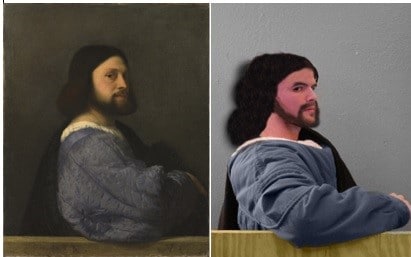The idea started with the Amsterdam Rijksmuseum and an Instagram account, Between Art and Quarantine: Recreate famous works of art using only household items. The Getty Museum soon issued its own challenge, limiting recreations of its collection to three household items. Inspired by the idea, comparative cultural studies faculty Alexandra Carpino and Rebekah Pratt-Sturges challenged students in their art classes.
Students were asked to recreate works of art covered in their respective courses. Carpino and Pratt-Sturges saw this as a unique way to engage students and study artwork from a new perspective. Students’ chose their recreation and were limited to using items in their home or dorm rooms to substitute and position objects for a photograph that resulted in a mirror image of the original.
“I am always on the lookout for ways to get my students to apply what they are learning in the classroom,” Carpino said. “When I saw some of the recreations on Facebook, I knew I had found the perfect project for them to become deeply engaged with one of the works they were studying in our final unit on Romanesque and Gothic art, and hopefully have some fun in the process.”
Students learned about art history by examining their piece closely and applying visual acuity skills emphasized in all of the art history courses.
“Essentially they are using the three dimensional to recreate a two-dimensional work,” Pratt-Sturges said. “This requires thinking carefully about how your objects will appear on a flat surface, something that all artists grapple with. Many students mentioned they have a deeper appreciation for just how difficult it can be to design a work of art and to understand the visual element of perspective.”
Creativity was tested. Kayley Zeno, psychological sciences and criminal justice major, and Liliah Boatman, environmental and sustainable studies major, both faced challenges.
Zeno chose to recreate a French Romanesque capital showing the Flight into Egypt from Autun, France. A haloed woman holds a child on her lap. Using a teddy bear as a stand in for the child, Zeno found she still needed to fashion a flat halo.
“With help from a friend, I decided to tape a plate to the wall and position myself accordingly,” Zeno said.
Boatman recreated the Romanesque reliquary of Sainte-Foy from Conques, France. With the original piece covered in gold, she struggled to find an imitation material, but she had another concern.
“It was a challenge to walk the line between light-hearted imitation and being disrespectful of the original piece,” Boatman said.
Overcoming the challenges made the project worth the effort. Interior design major Hannah White said the project gave her a creative outlet and a way to apply concepts she learned in class while isolated at home.
The results not only showed the humor and creativity of students, but also the power of what creative activities can do for people during quarantine.
“We need art now more than ever.” Carpino said.
“Art has always been a means of expression during times of joy and also hardship,” Pratt-Sturges said. “Through art, humanity can grapple with the immense cultural shift we are all facing. It can provide us hope that better times lay ahead by reminding us of how humanity survived trials and tribulations of the past. We can take joy in beauty and solace in melancholy.”
“Art is a way for people to stay connected and reminds us of beautiful things during this time,” Zeno said. “It provides comfort and stability in times when the world is everything but.”
Connection, distraction and stability are just a few ways art can help people through uncertain times.
“Not only does art occupy time within a life of quarantine, but it also continues to connect us with other students and professors, as well as complete strangers,” Boatman said. “I think the fact that recreating art has become viral on social media creates a sense of connection within these uncertain times of society. This art helps to bring joy to the world in a time that desperately needs some laughter.”
“American Gothic,” by Grant Wood—Recreated by Jacob McDaniel
“Man with a Blue Sleeve,” by Titian—Recreated by Maxwell Fisher
“Soap Bubbles,” by Jean-Simeon Chardin—Recreated by Heaven Dobkins
A French Romanesque capital showing the Flight into Egypt—Recreated by Kayley Zeno
Detail of “Kiss of Judas,” by Duccio di Buoninsegna—Recreated by Jacob Olson
The Romanesque reliquary of Sainte-Foy from Conques, France—Recreated by Liliah Boatman
“Woman Holding a Balance,” by Johannes Vermeer—Recreated by Maddie Fyffe
The sculptures of the Annunciation and Visitation from Reims Cathedral, France—Recreated by Hannah White
Jacklyn Walling | NAU Communications











